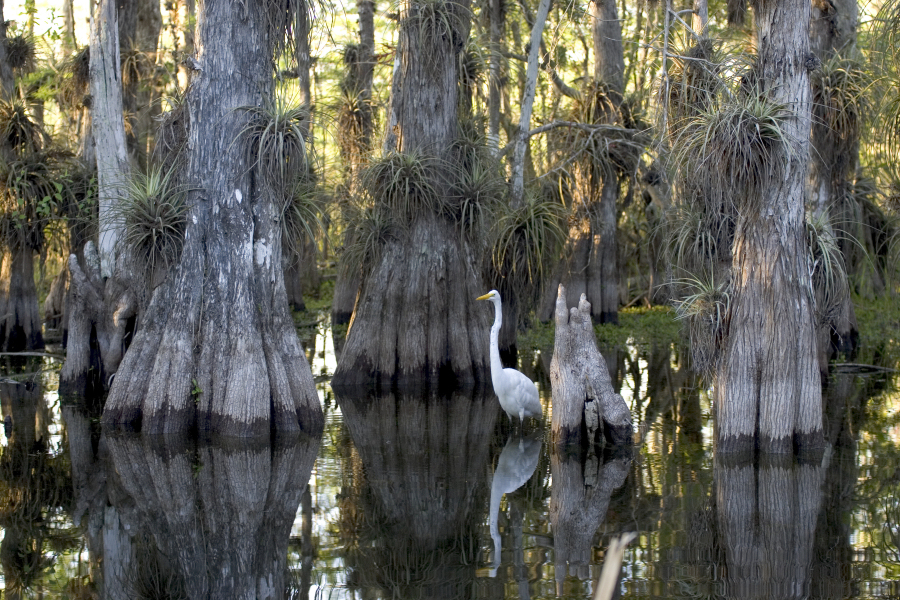On April 22, Earth Day 2015, President Barack Obama will travel to Everglades National Park in Florida and talk about man-made climate change.
… on Earth Day, I’m going to visit the Florida Everglades to talk about the way that climate change threatens our economy. The Everglades is one of the most special places in our country. But it’s also one of the most fragile. Rising sea levels are putting a national treasure – and an economic engine for the South Florida tourism industry – at risk.
– President Barack Obama, Weekly Address April 18, 2015
#ActOnClimate
UPDATE: The President’s speech
Transcript

Great Egret at Everglades National Park in Florida – nps.gov
Obama’s choice of the Florida Everglades as the setting for the speech is significant for the ecologically delicate nature of the area, as well as the fact that parts of the state are already routinely dealing with the effects of sea level rise as a result of climate change. Miami is regularly subject to “sunny day flooding” when tidal waters back up through the city’s drains. […]
Florida Sen. Marco Rubio, a Republican candidate for the presidency in 2016, has questioned the role of humans in climate change and voted against an amendment holding Congress to the view that humans are causing climate change.
~
With legislative efforts dead on Capitol Hill in the face of Republican opposition, Obama has sought to move forward on his own in ways large and small. The trip, on Earth Day, to the 734 square-mile tropical wetlands is aimed at highlighting a region that the administration said is threatened by global warming.
“The Everglades are flat, and they border a rising ocean,” Brian Deese, a senior adviser to Obama, wrote on the White House blog. “As the sea levels rise, the shorelines erode, and that salty water travels inland, threatening the aquifers supplying fresh drinking water to Floridians.”
Deese tied the potential damage to the economy — namely, the state’s tourism industry — and added that “we’re far beyond a debate about climate change’s existence. We’re focused on mitigating its very real effects here at home.”
More on the Everglades below the fold …
From the White House Email: Tell Us, What Would You Fight to Protect?
Here’s where the President is traveling for the very first time this Wednesday:
That’s the Everglades — one of our country’s most unique and treasured landscapes. But Wednesday’s trip is about more than touring an iconic National Park on Earth Day. Here’s why:The Everglades are flat, and they border a rising ocean. As the sea levels rise, the shorelines erode, and that salty water travels inland, threatening the aquifers supplying fresh drinking water to Floridians. That doesn’t just destroy a beautiful and unique national landscape. It threatens an $82 billion state tourism economy, and drinking water for more than 7 million Americans — more than a third of Florida’s population.
This Earth Day, we’re far beyond a debate about climate change’s existence. We’re focused on mitigating its very real effects here at home, preparing our communities where its impacts are already being felt, and leading an international effort for action. And the President has already acted in big ways. Over the last eight years, the United States has cut more carbon pollution than any other country, while creating 12.1 million private-sector jobs over 61 months; setting aside more public lands and waters than any Administration in history; and releasing a Clean Power Plan to curb carbon pollution from existing power plants — the single-biggest source of carbon pollution in the U.S.
~
America’s Everglades – The largest subtropical wilderness in the United States
Everglades National Park protects an unparalleled landscape that provides important habitat for numerous rare and endangered species like the manatee, American crocodile, and the elusive Florida panther.
An international treasure as well – a World Heritage Site, International Biosphere Reserve, a Wetland of International Importance, and a specially protected areas under the Cartagena Treaty.
Visit the park through photos and videos.


13 comments